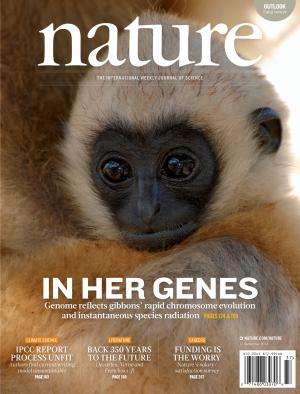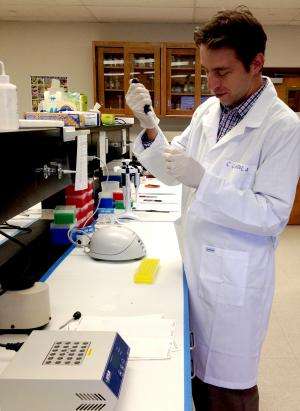Researcher uses genes to map evolution of species

Genes, whether from apes or the trees they live in, are the storytellers of the origins of a species, according to a Texas A&M University ecosystem science and management assistant professor in College Station.
Dr. Claudio Casola, in his first year at Texas A&M as a forest genomicist, analyzes large molecular data sets—mainly DNA sequences of genomes—to determine patterns of gene evolution.
Casola said genes are DNA strings containing the basic information to build and maintain cells, tissues and essentially the whole organism. And, his interest is in understanding the specific role of each gene and how the genes in different species originated and function – regardless of species.
Recently, his research on DNA was included in articles being published in two different journals, Nature and Nature Genetics. The two articles describe the sequencing and analysis of several primate genomes. The Nature paper concerns gibbons, while the Nature Genetics paper is about the common marmoset, a small South American monkey important to biomedical research.
While he has published and presented research focused on a variety of genomic analyses of animals, plants and fungi genomes, Casola's current position is specifically aimed at understanding the genetics and genomics of pine trees and other economically and ecologically relevant tree species, especially in the U.S. and Texas.
While not directly related to his current work, the research Casola conducted for these papers is very similar to what he is doing now in relation to forest trees.
"In fact, my work for these two studies was aimed at finding gene duplications and gene losses across these and other primates, including humans," he said.
Casola said 'gene duplication' is the process that makes genes more abundant and is a major driver of evolution and species diversity.
"I take advantage of public databases of DNA information in genome sequences or the complete DNA information of a species, which is currently available for a number of organisms. I also generate my own genomic data sets whenever possible or needed.
"A key aspect of my work is the comparative analysis of gene data," he said. "By looking at what genes have become more abundant or have been lost in a species compared to another species, I can infer the molecular basis of some biological differences between these species."

The studies on the gibbons and marmoset genomes are the result of large collaborations involving several labs in the U.S. and other countries, Casola said. The main goals of both works include improving the general knowledge of these primate genetics and genomics to better understand human evolution, human biology and the molecular causes of human diseases.
"Improving our knowledge of the biology of these animals and providing better molecular tools for conservation purposes of endangered species are other fundamental aims of these projects," he said.
Gibbons, also known as lesser apes, evolved a combination of anatomical features that allow them to swing at high speed from branch to branch for distances up to 50 feet. They also have experienced a uniquely high level of chromosomal breaks and fusions among primates that possibly accelerated the speciation process in this group.
Casola said 19 known gibbon species represent three-quarters of all ape species.
In the Nature article, the team presents the genome assembly for a female northern white-cheeked gibbon, he said. They uncovered a group of gibbon-specific retrotransposons—short DNA sequences able to make many copies of themselves that eventually 'attach' somewhere in the genome—that could be implicated in chromosomal reshuffling experienced by gibbons.
The genome of primates, including humans, host millions of retrotransposon copies. However, the gibbon-specific retrotransposons known as LAVA elements might have disrupted the activity of some genes involved in chromosomal organization, he explained.
"Interestingly, my comparative analysis of primate genomes shows that in contrast to the high chromosomal rearrangement levels, gene duplications and gene losses have not been particularly elevated in gibbons," Casola added. "This finding suggests that whatever process is responsible for the chromosomal rearrangements, it did not speed up gene turnover."
He performed a similar analysis in the common marmoset, a species in which females often give birth to dizygotic twins.
"In my work on the common marmoset genome, I identified hundreds of gene duplication and loss events that have occurred in the past 40 million years. At the same time, studying this genome allowed me to find several genes that have been lost during the evolution of humans, but are still present in this monkey and other mammals," Casola said.
Dissecting the genome organization and gene evolution of pine trees will be more challenging than in primates, he said.
"Pine tree genomes contain between 20-35 billion bases, or 'letters,' which is seven to 11 times the size of our own genome. In other words, they are much more difficult to decode," Casola said. "However, several pine tree and spruce genomes have already been sequenced, including the loblolly pine tree, which is the primary commercial forest species in the Southeastern United States. This will have a great impact on the genetics research in these species."
Casola said his research is already taking advantage of these resources, and is also focusing on improving the sequence of the loblolly pine genome.
"Even after sequencing a genome you always end up having lots of short sequences that are very hard to put together," he said. "One of my goals is to find better ways to join these pieces by working with other researchers at Texas A&M University, the Texas A&M Forest Service and the USDAForest Service Southern Research Station," he said.
This effort will be important to develop genetic tools that can help improve the wood quality of commercial pine trees, and potentially obtain trees more resistant to drought and pests through breeding, Casola said.
"I've always enjoyed digging into genomic data to find out how genes and species evolved," he said. "Now I can apply this information to understand how pine trees adapted to their environment, and hopefully this will translate into tools that can help contain the effects of climate change on some of our forests."
More information: "Gibbon genome and the fast karyotype evolution of small apes." Lucia Carbone, R. Alan Harris, Sante Gnerre, Krishna R. Veeramah, Belen Lorente-Galdos, John Huddleston, Thomas J. Meyer, Javier Herrero, Christian Roos, Bronwen Aken, Fabio Anaclerio, Nicoletta Archidiacono, Carl Baker, Daniel Barrell, Mark A. Batzer, Kathryn Beal, Antoine Blancher, Craig L. Bohrson, Markus Brameier, Michael S. Campbell, Oronzo Capozzi, Claudio Casola, Giorgia Chiatante, Andrew Cree, Annette Damert Nature 513, 195–201 (11 September 2014) DOI: 10.1038/nature13679
"The common marmoset genome provides insight into primate biology and evolution." The Marmoset Genome Sequencing and Analysis Consortium Nature Genetics 46, 850–857 (2014) DOI: 10.1038/ng.3042
Journal information: Nature , Nature Genetics
Provided by Texas A&M University



















